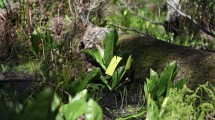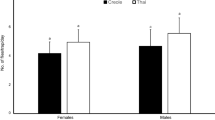Abstract
Bioassays with a variety of overripe fruits, including mango, plum, pear, and grape, and their extracts showed that odors from overripe mango were most attractive to adult vinegar flies, Drosophila melanogaster. Combined gas chromatography–electroantennographic detection (GC-EAD) analyses of solid-phase microextraction (SPME) and Tenax extracts of overripe mango odors showed that several volatile compounds, including ethanol, acetic acid, amyl acetate, 2-phenylethanol, and phenylethyl acetate elicited significant EAG responses from antennae of female flies. Most of the volatile compounds in the extracts were identified by mass spectral and retention index comparisons with synthetic standards. In cage bioassays, lures with a blend of ethanol, acetic acid, and 2-phenylethanol in a ratio of 1:22:5 attracted six times more flies than any single EAG-active compound. This blend also attracted four times more flies than traps baited with overripe mango or unripe mango. However, in field trials, the blend was not as attractive as suggested by the laboratory bioassay.
Similar content being viewed by others
References
Barrows, W. M. 1907. Reaction of pomace fly to odorous substances. J. Exp. Zool. 4:515–540.
Bartley, J. P. and Schwede, A. 1987. Volatile flavor components in the headspace of the Australian or Bowen mango. J. Food Sci. 52:353–360.
Boulanger, R. and Crouzet, J. 2001. Identification of the aroma components of acerola (Malphigia glabra L.): free and bound flavour compounds. Food Chem. 74:209–216.
Fischer, U., Strasser, M., and Gutzler, K. 2000. Impact of fermentation technology on the phenolic and volatile composition of German red wines. Int. J. Food Sci. Technol. 35:81–94.
Haynes, K. F., Zhao, J., and Latif, A. 1991. Identification of floral compounds from Abelia grandiflora that stimulate upwind flight in cabbage looper moths. J. Chem. Ecol. 17:637–646.
Hunter, S. H., Kaplan, H. M., and Enxmann, E. V. 1937. Chemicals attracting Drosophila. Am. Nat. 71:575–581.
MacLeod, A. J. and De Troconis, N. G. 1982. Volatile flavour compounds of guava. Phytochemistry 21:1339–1342.
MacLeod, A. J. and Snyder, C. H. 1985. Volatile components of two cultivars of mango from Florida. J. Agric. Food Chem. 33:380–384.
MacLeod, A. J., MacLeod, G., and Subramanian, G. 1988. Volatile constituents of orange. Phytochemistry 27:2185–2188.
McInnis, D. O. and Warthen, J. D. 1988. Mediterranean fruit fly (Diptera: Tephritidae): Laboratory bioassay from attraction of males to leaf or stem substance from Ficus and Litchi. J. Econ. Entomol. 81:1637–1640.
Nout, M. J. R. and Bartelt, R. J. 1998. Attraction of a flying nitidulid (Carpophilus humeralis) to volatiles produced by yeasts grown on sweet corn and a corn-based medium. J. Chem. Ecol. 24:1217–1239.
Ollè, D., Baumes, R. L., Bayonove, C. L., Lozano, Y. F., Sznaper, C., and Brillouet, J.-M. 1998. Comparison of free and glycosidically linked volatile components from polyembryonic and monoembryonic mango (Mangifera indica L.) cultivars. J. Agric. Food Chem. 46:1094–1100.
Picinelli, A., Suarez, B., Moreno, J., Rodriguez, R., Garcia, L. Caso, Bedrinana, R. Pando, and Mangas, J. J. 2000. Analytical techniques in the quality control and characterization of Austrian natural cider. Alimentaria (Madrid) 315:129–136.
Reed, M. R. 1938. The olfactory reactions of Drosophila melanogaster Meigen to the products of fermenting banana. Physiol. Zool. 11:317–325.
Sakho, M., Crouzet, J., and Seck, S. 1985. Volatile components of African mango. J. Food Sci. 50:548–550.
TNO. 1996. Mango (Mangifera indica) (105), pp 1-10, in L. M. Nijssen, C. A. Visscher, H. Maarse, L. C. Willemsens, and M. H. Boelens. (Eds.). Volatile Compounds in Food. Qualitative and Quantative Data. TNO Nutrition and Food Research Institute, Zeist, The Netherlands.
West, A. S. 1961. Chemical attractants for adult Drosophila species. J. Econ. Entomol. 54:677–681.
Winterhalt, P. 1991. Fruits IV. pp 389-409, in H. Maarse. (ed.). Volatile Compounds in Foods and Beverages. Marrel Dekker, New York.
Wong, K. C. and Siew, S. S. 1994. Volatile components of the fruits of bambangan (Mangifera panjang Kostermans) and binjai (Mangifera caesia Jack). Flav. Frag. J. 9:173–178.
Zhang, Z. and Pawliszyn, J. 1993. Headspace solid-phase microextraction. Anal. Chem. 65:1843–1852.
Zhu, J., Cossé, A. A., Obrycki, J. J., Boo, K. S., and Baker, T. C. 1999. Olfactory reactions of the twelve-spotted lady beetle, Coleomegilla maculata and the green lacewing, Chrysoperla carnea to semiochemicals released from their prey and behavioral responses. J. Chem. Ecol. 25:1163–1177.
Zilkowski, B. W., Bartelt, R. J., Blumberg, D. J., David G., and Weaver, D. K. 1999. Identification of host-related volatiles attractive to pineapple beetle Carpophilus humeralis. J. Chem. Ecol. 25:229–252.
Author information
Authors and Affiliations
Corresponding author
Rights and permissions
About this article
Cite this article
Zhu, J., Park, KC. & Baker, T.C. Identification of Odors from Overripe Mango That Attract Vinegar Flies, Drosophila melanogaster . J Chem Ecol 29, 899–909 (2003). https://doi.org/10.1023/A:1022931816351
Issue Date:
DOI: https://doi.org/10.1023/A:1022931816351




